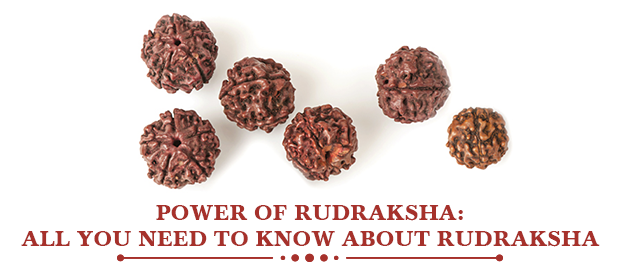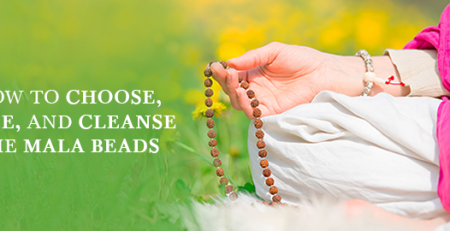Power of Rudraksha: All You Need to Know About Rudraksha
The Rudraksha bead has immense significance in spiritual traditions across the world. They are traditionally used as mālā beads to support spiritual practices such as japa and meditation. Rudraksha beads are actually dried seeds of a large evergreen tree (Elaeocarpus Ganitrus) that grows in South East Asia like Nepal and Indonesia. The word Rudraksha is a compound of two Sanskrit words; rudra is another name for Lord Shiva and aksha means ‘eye’.
The story goes that when Lord Shiva was meditating to end human suffering, tears of compassion fell on earth and took on the form of the seeds of the Rudraksha seeds. These sacred beads contain a storehouse of spiritual blessings within them, and bestow healing and protection on those who use them daily for spiritual practices.
A] Importance of Rudraksha Mālā in Daily Life
Many ancient texts extol the power of Rudraksha beads. Using Rudraksha beads in spiritual practices helps maintain physical, emotional and cognitive balance. It also helps foster peace, calm and tranquillity when used in the practice of japa. Some of the other benefits of using Rudraksha mālā or beads daily include:
- Lowered heart rate with improved blood circulation and digestion
- Protection from negative energies
- Aligning and harmonizing our energies with nature
- Alleviation of stress, depression and anxiety
- Increased mindfulness and emotional stability
- Improved focus and concentration
- Bringing about clarity of purpose, leading to enlightenment
B] Types of Rudraksha and Their Benefits
There are many types of Rudraksha beads that are typically classified according to the number of facets or faces (mukhi) the seeds have. The most widely used Rudraksha in mālās is the panchmukhi, with five facets or faces. The panchmukhi Rudraksha can be worn by anyone above the age of 14 and bestows upon the wearer purity of thoughts, inner peace, intellectual growth, mindfulness and enhanced memory.
Some of the other types of Rudraksha that are used in japa mālās are the six-faced shanmukhi Rudraksha. A shanmukhi Rudraksha japa mālā is to be used by children below 14 years of age since it helps with their physical and cognitive development. Wearing the shanmukhi Rudraksha also dispels lethargy, listlessness and improves emotional stability.
The gowrishankar Rudraksha looks like two beads fused together and can be worn by individuals above 14 years of age. This type of Rudraksha has the power to activate the seven chakras and balance the energy channels. It also bestows upon the wearer blessings of prosperity, knowledge and wisdom.
C] Choosing the Right Rudraksha Mālā For You
The first and possibly the most important step is to form the intention for purchasing a mālā. Here is a detailed post with suggestions on how to choose mālā beads. Once you have made the decision to buy a Rudraksha mālā, here are a few things to consider to ensure you find the japa mālā that is just right for you.
1. The number of beads: Japa mālās are usually available in 27 beads, 54 beads or 108 beads. It might be helpful to choose the length that is most comfortable for you to use. For example, if you want to wear the mālā around your neck, you might opt for a longer mālā. If you intend to use the japa mālā during your daily walk, a shorter japa mālā with fewer beads might be more convenient.
2. The thread or string the beads are strung upon: Rudraksha japa mālās are strung on cotton or silk thread, silver chain or gold chain.
3. The size and feel of the beads: Rudrasksha are classified into Nepali Rudraksha and Indonesian Rudraksha indicating the origin or source of the actual beads. The Rudraksha from Nepal are usually larger and have deep defined grooves or ridges while those from Indonesia are smaller, have less defined grooves and may feel smoother which may make it easier to move the beads. It really is about personal preference and what feels comfortable to you.
Once again, the rule of thumb for choosing a Rudraksha japa mālā is to have a clear intention and follow your intuition to pick the japa mālā that you feel drawn, pulled or compelled towards.
D] More About Rudraksha Mālās
There is endless literature available about the dos and don’ts when it comes to caring for and using a Rudraksha japa mālā. We want to put your mind at ease and assure you that the Rudrakshas japa mālās and pendants in the Siddha Yoga India Bookstore have been through an exhaustive and rigorous selection process so that you don’t have to worry about it.
-
- The Rudraksha beads are procured from as close to the source of the supply chain as possible.
-
- Once they have been procured, they are cleaned with a special cleansing agent, after which they are conditioned in a specially formulated oil made from fragrant essential oil and other natural oils.
- At the end of the conditioning process, the natural colour of the beads is revealed.
Once the beads have been cleaned and conditioned, a comprehensive sorting process begins that incorporates up to 11 different parameters.
-
- The first level of sorting is done based on the colour of the Rudraksha while also eliminating beads that are damaged or have defects (khandit).
-
- The second level of sorting is done according to the mukhi or facets of the beads with highly specialised equipment in order to maintain the highest level of quality.
-
- Once they have been sorted according to the mukhi, they are further sorted by shades – light, medium and dark.
-
- After they have been sorted by shades, they are further sorted by size – small, medium and large.
- And the final stage of sorting ensures that the beads in one japa mālā are of the same shape, round or oval, for example.
After this exhaustive and detailed sorting procedure, about 20 to 30% of the beads meet all the criteria. These are used to make the products that you see on the Siddha Yoga India Bookstore.
The most unique aspect of this sorting process is that throughout the process a mantra or chant is played to further infuse the beads with blessings and auspicious energy.
FAQs About Rudraksha
Do all Rudraksha mālās have 108 beads?
No. The beads in a Rudraksha mālā vary depending on the size of the Rudraksha beads. Traditionally, for sacred jewellery, 108 beads were strung into a mālā with an extra one called the ‘guru’ bead to indicate the beginning or end of a round of repetition.
Who can wear a Rudraksha mālā?
Anyone can use or wear a Rudraksha mālā to aid and enhance their spiritual practices.
When can I wear a Rudraksha mālā?
You can wear the Rudraksha mālā at all times, even while sleeping. To ensure the mālā beads lasts for a long time, avoid bathing in very hot water with soaps with strong chemical composition. Hot water and strong chemicals may make the beads brittle and could end up cracking.
Can I share my Rudraksha mālā?
As with all spiritual tools, it is best not to share your Rudraksha mālā with someone else as the energy of Rudraksha tends to adapt to the wearer.
What if some of the beads in my Rudraksha mālā crack or break?
When you notice cracked or broken beads in your Rudraksha mālā, please replace the beads as soon as possible. Cracked or broken beads may alter the flow of energy, which may not be beneficial to the person wearing the Rudraksha mālā.
While these are general guidelines about Rudraksha mālās, trust in the power of the Rudraksha and your dedicated and consistent spiritual practice to guide you on how to use and care for your Rudraksha mālā.



